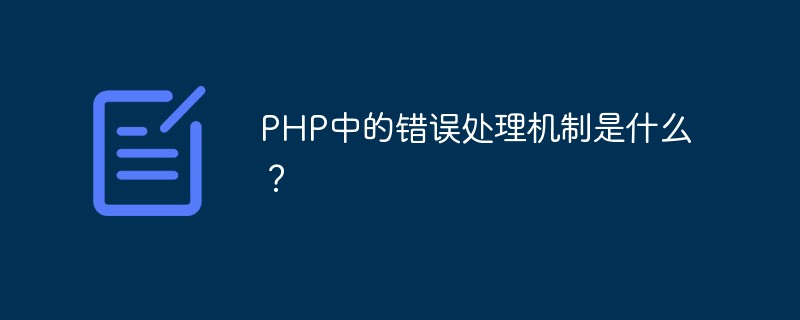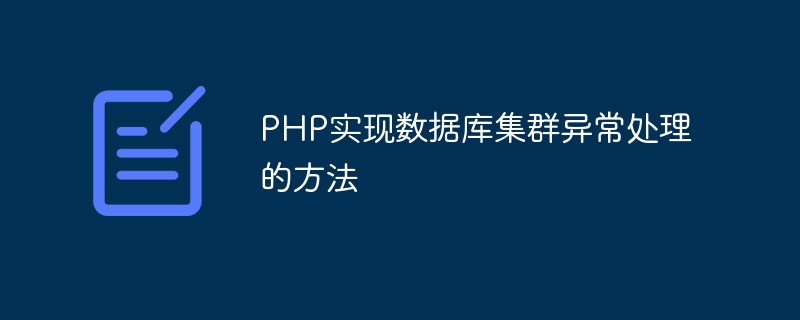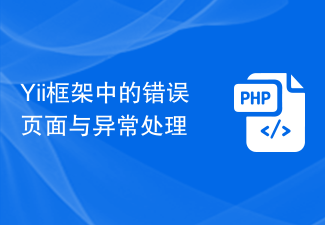In Python programming, when an error or exception occurs during code execution, the program will stop execution. In order to allow the program to continue executing when an exception occurs, Python provides an exception handling mechanism. This article will introduce readers to exception handling techniques in Python.
- try-except statement
In Python, you can use the try-except statement to handle exceptions. Its basic format is as follows:
try:
# 可能会出现异常的代码
except Exception as e:
# 如果出现异常,执行这里的代码In this try-except statement, the code that may cause exceptions needs to be placed in the try code block. If an exception occurs in the code in the try code block, it will jump to the except code block for execution instead of directly terminating the program.
It should be noted that Exception in the except statement is a general exception type. If you want to handle only specific types of exceptions, you can replace Exception with a specific exception type. For example:
try:
a = 10 / 0
except ZeroDivisionError as e:
print('除数不能为0。')In this code, we specify that we only handle exceptions like ZeroDivisionError. If other types of exceptions occur in the try code block, the program will crash directly.
- try-except-else statement
In addition to the try-except statement, Python also provides the try-except-else statement. Its basic format is as follows:
try:
# 可能会出现异常的代码
except Exception as e:
# 如果出现异常,执行这里的代码
else:
# 如果没有出现异常,执行这里的代码In this statement, the code in the else code block will only be executed when there is no exception in the code in the try code block. This statement is very useful when processing certain operations that require subsequent operations based on the results of code execution.
- try-except-finally statement
In addition to the try-except-else statement, Python also provides the try-except-finally statement. Its basic format is as follows:
try:
# 可能会出现异常的代码
except Exception as e:
# 如果出现异常,执行这里的代码
finally:
# 无论有没有出现异常,都会执行这里的代码In this statement, the code in the finally code block will be executed regardless of whether an exception occurs in the code in the try code block. This statement is very useful when cleaning work is required, such as closing files, closing database connections, etc.
- Throw exceptions
In Python, you can also use the raise statement to manually throw exceptions. Its basic format is as follows:
raise Exception('错误信息')In this statement, we manually threw an Exception and passed in an error message. This statement is useful when you need to manually detect certain situations and throw exceptions.
- Customized exceptions
In addition to using the exception types that come with Python, you can also customize exception types. Its basic format is as follows:
class CustomException(Exception):
passIn this code, we define an exception type named CustomException and let it inherit from Exception. In actual programming, we can customize different exception types as needed to make the code more readable and maintainable.
Summary
Exception handling is a very important part of Python programming. By using try-except statements, try-except-else statements, try-except-finally statements, and raise statements, the program can continue to run when an exception occurs, thereby improving the robustness and stability of the program. At the same time, custom exception types can make the code more readable and easier to maintain.
The above is the detailed content of Exception handling techniques in Python. For more information, please follow other related articles on the PHP Chinese website!
 PHP中API如何处理异常处理和重试机制Jun 17, 2023 pm 03:52 PM
PHP中API如何处理异常处理和重试机制Jun 17, 2023 pm 03:52 PMPHP中API如何处理异常处理和重试机制在PHP中,API已经成为许多网站和应用程序的核心,因为它们提供各种功能和功能。然而,在使用API时,我们经常会遇到许多问题,如网络连接问题,响应超时,无效请求等。在这种情况下,我们需要了解如何处理异常和重试机制来确保我们的应用程序的可靠性和稳定性。异常处理在PHP中,异常处理是一种更加优雅和可读的错误处
 PHP中的错误处理机制是什么?May 12, 2023 pm 07:31 PM
PHP中的错误处理机制是什么?May 12, 2023 pm 07:31 PMPHP是一种流行而强大的服务器端编程语言,可以用来开发各种Web应用程序。就像其他编程语言一样,PHP也有可能会出现错误和异常。这些错误和异常可能由各种原因引起,如程序错误、服务器错误、用户输入错误等等。为了确保程序的运行稳定性和可靠性,PHP提供了一套完整的错误处理机制。PHP错误处理机制的基本思想是:当发生错误时,程序会停止执行并输出一条错误消息。我们可
 Go语言框架开发中的异常处理与错误码设计Jun 05, 2023 pm 09:21 PM
Go语言框架开发中的异常处理与错误码设计Jun 05, 2023 pm 09:21 PM随着互联网技术的不断发展,越来越多的企业开始使用Go语言进行开发。Go语言以其高效、稳定、易用的特点备受开发者的青睐。在企业级开发中,框架是不可或缺的一部分。因此,本文将介绍在Go语言框架开发中,如何进行异常处理与错误码设计。一、什么是异常处理在计算机编程中,异常处理指的是当程序运行过程中出现异常情况时,程序必须采取的措施。这些异常情况包括硬件故障、软件缺陷
 Swoole实现高效的异常处理机制Jun 14, 2023 pm 03:54 PM
Swoole实现高效的异常处理机制Jun 14, 2023 pm 03:54 PM随着Web开发技术的不断发展,开发人员也面临着越来越复杂的业务场景和需求。例如,高并发、大量请求处理、异步任务处理等问题都需要使用高性能的工具和技术来解决。在这种情况下,Swoole成为了一种越来越重要的解决方案。Swoole是一种基于PHP语言的高性能异步网络通信框架。它提供了一些非常有用的功能和特性,例如异步IO、协程、进程管理、定时器和异步客户端,使得
 如何在ThinkPHP6中进行异常处理?Jun 12, 2023 am 08:54 AM
如何在ThinkPHP6中进行异常处理?Jun 12, 2023 am 08:54 AMThinkPHP6是一款非常流行的PHP框架,已经被广泛应用于各种Web应用程序中。在开发过程中,可能会遇到各种异常,如果不及时处理,就会导致程序无法正常运行。本文将介绍如何在ThinkPHP6中进行异常处理,保证Web应用程序的稳定性和可靠性。异常处理的概念异常处理是指在程序正常执行过程中,遇到错误或意外情况时所进行的处理。在开发Web应用程序时,常常会发
 PHP实现数据库集群异常处理的方法May 15, 2023 pm 02:40 PM
PHP实现数据库集群异常处理的方法May 15, 2023 pm 02:40 PM随着互联网的不断发展,越来越多的企业和组织开始规划数据库集群来满足其数据处理需求。数据库集群可能包含数百甚至数千个节点,因此在节点之间确保数据同步和协调非常重要。在该环境下,存在着很多的异常情况,如单节点故障,网络分区,数据同步错误等,并且需要实现实时检测和处理。本文将介绍如何使用PHP实现数据库集群异常处理。数据库集群的概述在数据库集群中,一个单独的
 Java中的异常处理Jun 15, 2023 pm 11:16 PM
Java中的异常处理Jun 15, 2023 pm 11:16 PMJava是一种面向对象的程序设计语言,由于其很高的稳定性和安全性,成为了一种广泛应用的编程语言。然而,在程序开发过程中,异常总是不可避免的问题。由于Java语言天生具有处理异常的功能,因此它可以通过异常处理机制来避免程序崩溃,保证程序的正常运行。一、Java中的异常概述在Java中,异常是指程序发生了不正常的情况,如数组越界、除数为零、文件未找到等等。但是这
 Yii框架中的错误页面与异常处理Jun 21, 2023 pm 03:27 PM
Yii框架中的错误页面与异常处理Jun 21, 2023 pm 03:27 PMYii框架是一款广泛应用于Web应用程序开发的高性能PHP框架。在Yii的应用程序中,错误页面和异常处理模块是非常重要的功能之一。本文将简要介绍Yii框架中的错误页面和异常处理模块,并提供一些实用的示例代码,以帮助您更好地理解和使用这些功能。一、错误页面当用户访问一个不存在的页面、发生了错误的连接或者其他错误时,Yii框架会默认显示一个错误页面。这个页面通常


Hot AI Tools

Undresser.AI Undress
AI-powered app for creating realistic nude photos

AI Clothes Remover
Online AI tool for removing clothes from photos.

Undress AI Tool
Undress images for free

Clothoff.io
AI clothes remover

AI Hentai Generator
Generate AI Hentai for free.

Hot Article

Hot Tools

Dreamweaver Mac version
Visual web development tools

Atom editor mac version download
The most popular open source editor

WebStorm Mac version
Useful JavaScript development tools

VSCode Windows 64-bit Download
A free and powerful IDE editor launched by Microsoft

Notepad++7.3.1
Easy-to-use and free code editor






